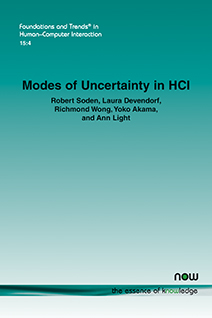Modes of Uncertainty in HCI
By Robert Soden, University of Toronto, Canada, soden@cs.toronto.edu | Laura Devendorf, University of Colorado Boulder, USA | Richmond Wong, Georgia Tech, USA, rwong34@gatech.edu | Yoko Akama, RMIT University, Australia, yoko.akama@rmit.edu.au | Ann Light, University of Sussex, UK, Ann.Light@sussex.ac.uk
Abstract
This monograph examines how HCI conceptualizes, situates, and responds to uncertainty—particularly arguing that our ability to respond to such uncertainties is governed to a great extent by the concepts we use to enframe a single, encompassing, overburdened and slippery idea. We propose four distinct “modes of uncertainty” as a means to begin to draw together the varied strands of work in HCI that address uncertainty in its many forms. The first, and most common, mode is to treat uncertainty as something in need of taming or disciplining. The second mode is to treat uncertainty as generative, or as a resource that can assist in human practices. The third is to look to the politics that shape how we encounter uncertainties and the fourth mode attends to the lived experience of uncertainty through affective dimension.
Rather than focus on uncertainty as a discrete phenomenon in the world to be studied, we look to how research goals, methods, and theoretical frames used in HCI research influence the various ways in which we encounter it. By switching from uncertainty (noun) to modes of engaging uncertainty (verb), we foreground uncertainty as a relational concept. We show that it is an active and ongoing condition that designers and researchers make present in different fashions depending upon their priorities and the context in which they are working. We will show that adding modes of uncertainty to our conceptual toolbox facilitates conversation between domains as diverse as disaster risk, maternal health, cybersecurity, and community organizing and lets us draw new connections between disparate areas of research including visualization studies, critical design, feminist epistemologies, and sustainability.
Modes of Uncertainty in HCI
Uncertainty is a prevalent characteristic of contemporary life and a central challenge of HCI. As humans, researchers, and designers we encounter uncertainty in a multitude of forms and a variety of settings. The growing attention to uncertainty in HCI is due to the ever increasing expansion of the field and questions and contexts to which we seek to apply HCI research and practice. It is also due to events in the world that force us to engage more directly with questions related to uncertainty. Consequently, society is turning more than ever to data as a means to enable or mediate our understanding of phenomena such as climate change, political turmoil, increased economic upheaval, and a global pandemic.
This monograph examines how HCI conceptualizes, situates, and responds to uncertainty — particularly arguing that our ability to respond to such uncertainties is governed to a great extent by the concepts we use to enframe a single, encompassing, overburdened and slippery idea. The authors propose four distinct “modes of uncertainty” to begin to draw together the varied strands of work in HCI that address uncertainty in its many forms. Rather than focusing on uncertainty as a discrete phenomenon in the world to be studied, they look to how research goals, methods, and theoretical frames used in HCI research influence the various ways in which we encounter it. By switching from uncertainty (a noun) to modes of engaging uncertainty (a verb), they foreground uncertainty as a relational concept and show that it is an active and ongoing condition that designers and researchers make present in different fashions depending upon their priorities and the context in which they are working. The authors show that adding modes of uncertainty to our conceptual toolbox facilitates conversation between domains and lets us draw new connections between disparate areas of research including visualization studies, critical design, feminist epistemologies, and sustainability.
